Stemming from the pride of his hometown Thanh Lieu - the cradle of woodblock engraving and printing, the birthplace of many talented artisans, Mr. Nguyen Cong Dat and many people who love woodblock engraving and printing have determined to gradually restore the once fading craft village.
From there, preserve and develop the precious heritage values of our ancestors.
Visited more than 100 temples to collect documents
Early October is a busy time for the craftsmen of Thanh Lieu woodblock carving and printing village (Tan Hung ward, Hai Phong city). Everyone is busy completing their works to contribute to the exhibition space "Hai Phong - Heritage Land" at the Con Son - Kiep Bac Autumn Festival in 2025.
Mr. Nguyen Cong Dat said that after 1.5 months, he had finished carving the picture of Con Son Pagoda, Kiep Bac Temple and the image of Saint Tran. Artisan Nguyen Cong Trang has completed many paintings, including the one of the Kiep Bac Temple gate. The painting "Truc Lam Dai Si Xuat Son Do" about the event of Buddha King Tran Nhan Tong's practice and enlightenment is still being worked on.
The works are all inspired by the first Festival season held after the Con Son-Kiep Bac relic site was recognized as a world cultural heritage.
Mr. Nguyen Cong Dat, born in 1992, is the youngest artisan in the craft village today. He said that history books recorded that the founder of the craft was the Third Prize Winner Luong Nhu Hoc, who was sent by the royal court to the Ming Dynasty (China) twice.
After returning from his diplomatic mission (15th century), he brought the woodblock engraving and printing craft back to his hometown, perfected it, and passed it on to the villagers of Hong Luc (or Hong Lieu, now Thanh Lieu residential area). This craft developed during the Later Le-Le Trung Hung period and reached its peak during the Nguyen Dynasty with the name of the Hong Lieu printing guild.
In the past, all three villages Thanh Lieu, Lieu Trang and Khue Lieu were taught by the founder of the craft, Luong Nhu Hoc. Throughout history, Thanh Lieu village has engraved and printed many products from scriptures, poems, decorative paintings, talismans, seals, votive paper money, Ten Things paintings...
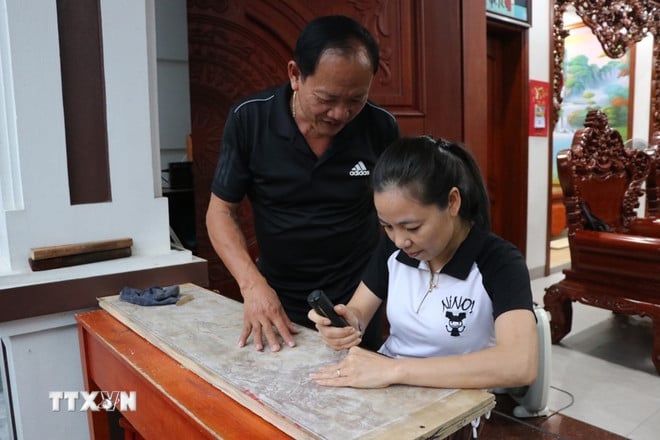
Artisan Nguyen Cong Trang guides student Pham Thi Tho in her apprenticeship. (Photo: Manh Minh/VNA)
The village’s artisans were proficient in woodblock carving, woodblock printing, and bookbinding. The ancient Thanh Lieu village not only traded in sutras, books, and paintings printed from woodblocks, but also sold pre-carved woodblocks.
Born in the homeland of woodblock engraving and printing, Mr. Nguyen Cong Dat always wondered: “In the past, the craft village had developed splendidly. Many woodblocks were recognized as national treasures, all of which clearly stated the names of the artisans who were from Thanh Lieu. However, the Thanh Lieu woodblock craft village is still little known. How can we preserve and develop the craft village to show gratitude to the ancestors and generations of artisans who have made great contributions?”
The idea of reviving the craft village began to grow in the young man in 2010 with the determination to collect related documents and records. “At that time, I was studying at Hanoi Open University. I started to learn about the history of the craft village, studied Chinese characters, and then went to collect evidence and artifacts at pagodas across the provinces and cities. Up to now, I have visited more than 100 pagodas to access the scriptures kept at the relics,” Dat said.
The journey helped Mr. Dat collect the handwritings of more than 200 artisans of Thanh Lieu craft village who had carved and printed precious scriptures and documents. Not stopping there, Mr. Dat also met with historians to get more documents to consolidate the actual documents he had collected.
He has collected a lot of valuable information about the history of the development of craft villages. Typically, in the early 19th century, artisans from Thanh Lieu village went to the capital Hue to carve woodblocks for the Nguyen dynasty, currently preserving nearly 35,000 woodblocks stored at the National Archives Center IV.
Also in the 19th century, artisans Nguyen Cong Thiem, Pham Tho Ninh, Pham Tho Ky, Nguyen Van Ke, and Nguyen Trung Hien carved and printed 7 sets of Buddhist scriptures, including more than 700 woodblocks at Tram Gian Pagoda (An Phu commune, Hai Phong city), and the woodblock storage is currently being kept at the pagoda.
The main tool for woodblock carving is the unique horizontal knife created by the founder Luong Nhu Hoc.
The handle is made of round, turned buffalo horn with a groove in the middle. The body is 23cm long and the blade is 1cm wide, 0.3cm thick with a curved, notched blade. The carving board is usually made of rosewood. In addition, there are a number of auxiliary tools.
“After learning more about the craft, I collected tools, woodblocks, and ancient prints and brought them back to the village as evidence of a profession that had flourished. I also called on the remaining artisans to establish an Association to preserve and promote the craft of woodblock engraving and printing; to promote and spread the values of the craft’s heritage to the community,” said Nguyen Cong Dat.
The collection took many years and was not easy, but he was determined because he thought this was a way to show gratitude to his ancestors and forefathers who had taught him a precious profession.
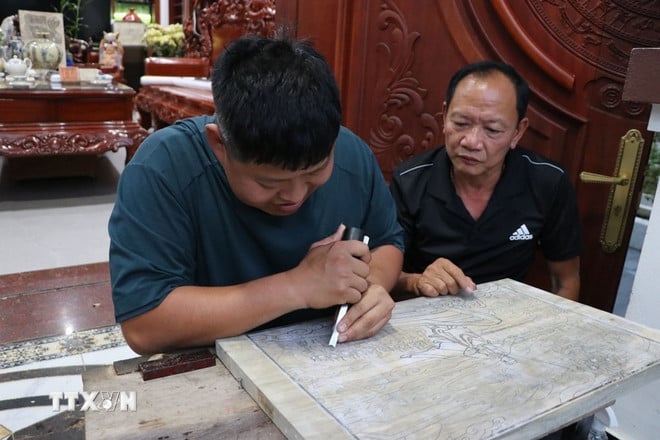
Artisan Nguyen Cong Trang (right) gives advice to Nguyen Cong Dat during the woodblock engraving and printing process. (Photo: Manh Minh/VNA)
Step by step restoration of craft villages
Nguyen Cong Dat’s idea of restoring the craft village was supported by skilled craftsmen in the village. Artisan Nguyen Cong Trang, born in 1962, who has more than 40 years of experience in woodblock engraving and printing, was one of the first to respond and actively accompany.
“In the 1980s and 1990s, the village still had a lot of work to do, but then society developed and handicrafts gradually could not compete with machines. I had to do other jobs to make a living and stopped working for more than 20 years. Three years ago, when I heard that Dat had an idea, I immediately supported him because that was what we really wanted,” said artisan Nguyen Cong Trang.
After many efforts and proposals from woodblock engraving and printing workers, in December 2024, Tan Hung Ward People's Committee issued a Decision to establish Thanh Lieu Woodblock Association and at the end of 2024, Thanh Lieu woodblock engraving and printing craft village was recognized.
Now, at the age of 63, artisan Nguyen Cong Trang is back to his old job. He not only engraves and prints famous works and valuable documents, but also creates new models and guides and teaches the young generation, including new students in grade 11.
Ms. Pham Thi Tho, born in 1985, is a new student and the only female member of the Association. Up to now, she has directly created a number of works: Female General Le Chan, Buddha Tathagata...
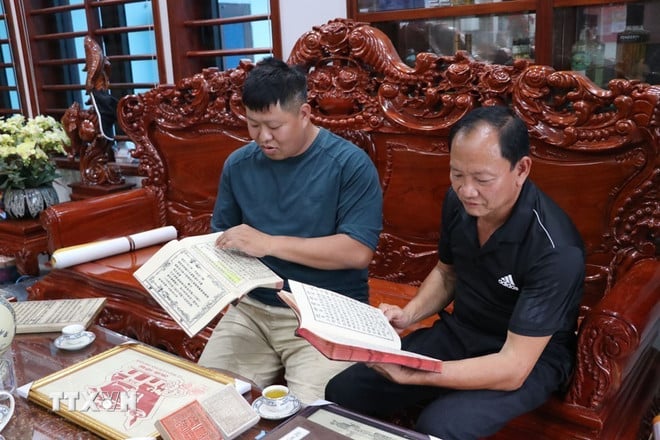
Artisans Nguyen Cong Trang (right) and Nguyen Cong Dat discuss documents and artifacts related to the woodblock engraving and printing profession. (Photo: Manh Minh/VNA)
“At first, I learned the printing process, then learned engraving techniques. This job requires love, patience, and carefulness, and the more I learn and do, the more I love and appreciate the job,” Ms. Tho shared.
Currently, Thanh Lieu woodblock engraving and printing village receives orders to restore ancient prints for painting villages and ancient prints for relics; Create new product models suitable for current people's tastes; Organize promotions, experiences and target tourists. Participating in cultural events in many provinces and cities helps the name of the craft village become more widely known.
According to Mr. Nguyen Cong Dat, the craft village plans to cooperate with the National Archives Center IV, researchers, museums, pagodas that are currently preserving ancient woodblocks of Thanh Lieu village, the Con Son-Kiep Bac Relic Management Board, etc. to propose organizing seminars, displaying products and ancient artifacts, in order to build a tourist destination to experience the woodblock carving and printing profession in the village.
Hope to have a museum about craft villages soon
Nowadays, with the development of printing machines and techniques, the woodblock printing and engraving market is no longer as prosperous as before. The number of households practicing the profession is very small.
Artisan Nguyen Cong Trang hopes that the young generation will know how to apply technology to update new and modern things, and basically still have to preserve the quintessence of manual elements, the unique features of the ancient profession left by their ancestors.
In addition, to preserve and develop the woodblock engraving and printing profession, the city's attention, support and investment are needed. Mr. Trang and the artisans of the craft village hope to have a cultural space to preserve the knowledge of the woodblock engraving and printing profession built in Thanh Lieu's homeland.
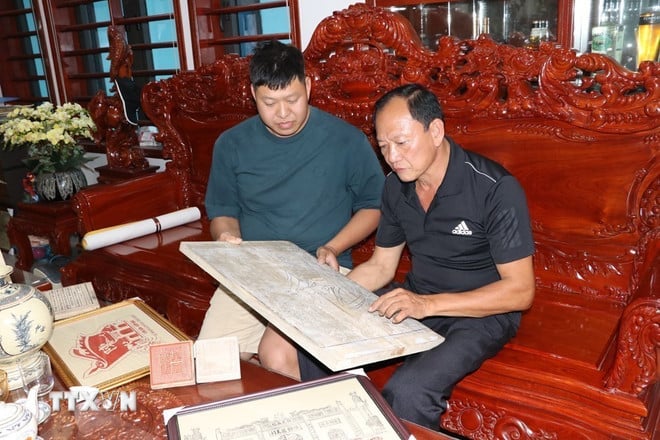
Artisans Nguyen Cong Trang (right) and Nguyen Cong Dat discuss woodblock engraving and printing works on the theme of Con Son-Kiep Bac relic site. (Photo: Manh Minh/VNA)
“I hope the city will pay attention to organizing seminars on the history and great value of the woodblock engraving and printing profession, and devote resources to building a spacious place to worship the ancestors and a museum about the craft village to match the significance and historical significance that the woodblock engraving and printing profession has contributed to the development of the country,” said Nguyen Cong Dat.
The artisans also hope that if a museum about the craft village is built, this place will become a tourist product that attracts domestic and foreign tourists. As for the local people, this is a place to teach the craft and educate the young about tradition and history.
For a craft village to survive and promote its value, each artisan must constantly research, innovate, and create new works that suit the increasingly rich and diverse aesthetic tastes of the people.
Along with that, it is necessary to have the support of the government and departments of Hai Phong city in encouraging and creating conditions for the values of traditional crafts to be preserved, promoted and spread./.
(TTXVN/Vietnam+)
Source: https://www.vietnamplus.vn/hai-phong-no-luc-bao-ton-nghe-khac-in-moc-ban-cua-cha-ong-post1068499.vnp



![[Photo] Prime Minister Pham Minh Chinh chairs the 16th meeting of the National Steering Committee on combating illegal fishing.](https://vphoto.vietnam.vn/thumb/1200x675/vietnam/resource/IMAGE/2025/10/07/1759848378556_dsc-9253-jpg.webp)







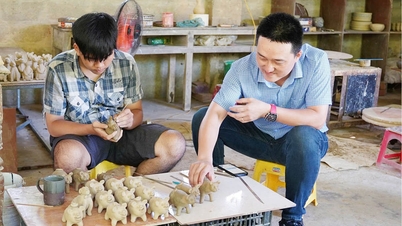












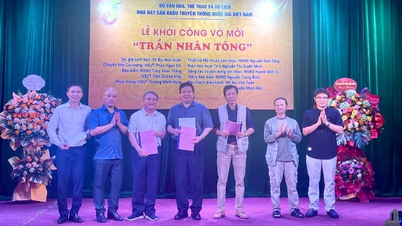














![[Photo] Super harvest moon shines brightly on Mid-Autumn Festival night around the world](https://vphoto.vietnam.vn/thumb/1200x675/vietnam/resource/IMAGE/2025/10/07/1759816565798_1759814567021-jpg.webp)













































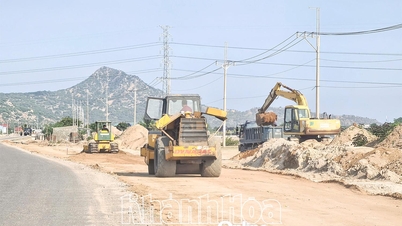




















Comment (0)